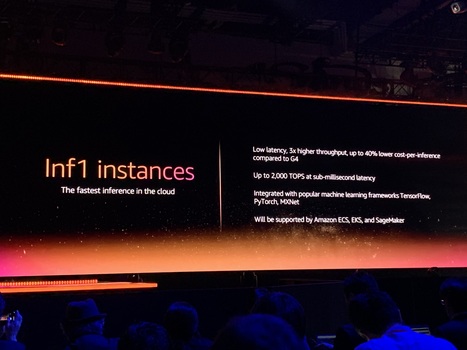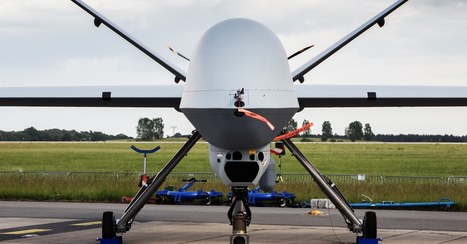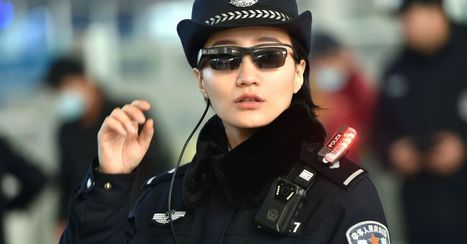 Your new post is loading...
 Your new post is loading...
At its re:Invent conference, AWS today announced the launch of its Inferentia chips, which it initially announced last year. These new chips promise to make inferencing, that is, using the machine learning models you pre-trained earlier, significantly faster and cost effective. As AWS CEO Andy Jassy noted, a lot of companies are focusing on custom chips that let you train models (though Google and others would surely disagree there). Inferencing tends to work well on regular CPUs, but custom chips are obviously going to be faster. With Inferentia, AWS offers lower latency and three times the throughput at 40% lower cost per inference compared to a regular G4 instance on EC4. The new Inf1 instances promise up to 2,000 TOPS and feature integrations with TensorFlow, PyTorch and MXNet, as well as the ONNX format for moving models between frameworks. For now, it’s only available in the EC2 compute service, but it will come to AWS’s container services and its SageMaker machine learning service soon, too.
How Fireflies.ai works? Users can connect their Google or Outlook calendars with Fireflies and have our AI system capture meetings in real-time across more than a dozen different web-conferencing platforms like Zoom, Google Meet, Skype, GoToMeeting, Webex, and many more systems. These meetings are then indexed, transcribed, and made searchable inside the Fireflies dashboard. You can comment, annotate key moments, and automatically extract relevant information around numerous topics like the next steps, questions, and red flags. Instead of spending time frantically taking notes in meetings, Fireflies users take comfort knowing that shortly after a meeting they are provided with a transcript of the conversation and an easy way to collaborate on the project going forward. Fireflies can also sync all this vital information back into the places where you already work thanks to robust integrations with Slack, Salesforce, Hubspot, and other platforms. Fireflies.ai is the bridge that helps data flow seamlessly from your communication systems to your system of records. This approach is possible today because of major technological changes over the last 5 years in the field of machine learning. Fireflies leverage recent enhancements in Automatic Speech Recognition (ASR), natural language processing (NLP), and neural nets to create a seamless way for users to record, annotate, search, and share important moments from their meetings. Who is Fireflies for? The beauty of Fireflies is that it’s been adopted by people in different roles across organizations big and small: - Sales managers use Fireflies to review their reps’ calls at lightning speed and provide on the spot coaching
- Marketers create key customer soundbites from calls to use in their campaigns.
- Recruiters no longer worry about taking hasty notes and instead spend more time paying attention to candidates during interviews.
- Engineers refer back to specific parts of calls using our smart search capabilities to make everyone aware of the decisions that were finalized.
- Product managers and executives rely on Fireflies to document knowledge and important initiatives that are discussed during all-hands and product planning meetings on how to get access Fireflies have a free tier for individuals and teams to easily get started. For more advanced capabilities like augmented call search, more storage, and admin controls, we offer different tiers for growing teams and enterprises. You can learn more about our pricing and tiers by going to fireflies.ai/pricing.
In the UK and Germany, the proportion is even higher: one in three. In the Netherlands, fully 43 percent want AI to decide policy.
LAST SUMMER, A sign appeared on the door to a stuffy, windowless room at the office of Manhattan artificial-intelligence startup Clarifai. “Chamber of secrets,” it read, according to three people who saw it.
The notice was a joking reference to how the small team working inside was not permitted to discuss its work with others at Clarifai. Former and current employees say the group was working on a controversial Pentagon project using machine-learning algorithms to interpret drone-surveillance imagery—and that Clarifai’s secrets were less safe than they should have been.
A lawsuit filed by former employee Amy Liu this month alleges that Clarifai’s computer systems were compromised by one or more people in Russia, potentially exposing technology used by the US military to an adversary. The lawsuit says Clarifai learned of the breach last November, but that Clarifai’s CEO and other executives did not promptly report it to the Pentagon.
In her complaint, Liu, a former Air Force captain who worked in military intelligence, says she was unfairly terminated from her position as director of marketing for arguing that the company needed to disclose the incident. Another former employee told WIRED that his concerns over executives’ handling of the hack prompted him to leave the company.
For some years now, there has been a tension between the world’s largest tech companies— Alphabet, Amazon.com, Facebook, Apple, Microsoft, Baidu, and Alibaba Group Holding—and the chip companies they rely on, especially Intel and Nvidia. While the giants buy massive quantities of Intel’s (ticker: INTC) microprocessors, and Nvidia’s (NVDA) graphics chips, or GPUs, to power their data centers, they are also in an arms race to have the best artificial-intelligence-based machine-learning functions. Because of this, there was always the possibility the giants might decide to buy fewer off-the-shelf parts and make their own custom chips to get an edge on one another. That prospect burst onto the scene again last week as Bloomberg reported that job listings at Facebook (FB), and remarks by unnamed sources, indicate that the social-networking giant is working on making its own chips. The development, if true, is not surprising. Barron’s wrote 2½ years ago about how AI might push the giants to make their own parts (“Watch Out Intel, Here Comes Facebook,” Oct. 31, 2015). One of the chief sources in that article was none other than Facebook’s guru of machine learning, Yann LeCun. Facebook declined to make LeCun available, but in that 2015 interview he outlined a dilemma Facebook confronts with machine learning that has probably not changed since then. Facebook receives hundreds of millions of photographs from its users on a daily basis. Its computers must analyze, within a couple of seconds of a picture being uploaded, whether to show that picture to one of your friends, to block it for questionable content, and to tag the images with your friends’ names, using facial recognition—all examples of machine learning. As LeCun explained, machine learning is breaking the current generation of chips. The amount of media continues to rise and down the road is more complex media. Imagine a future where people upload 3-D models of places they’ve been from their next-generation smartphones. “The amount of infrastructure if we use the current type of CPU [central processing unit] is just going to be overwhelming,” he remarked. LeCun said that Facebook is receptive to Intel or another vendor making its own neural-network processor, but he warned, “If they don’t, then we’ll have to go with an industry partner who will build hardware to specs, or we’ll build our own.” LeCun and Facebook may have decided now is the time to go it alone. Intel’s plans to have its own AI chip have not yet borne fruit in terms of shipping parts. Nvidia is really the undisputed leader in AI chips. That brings with it a certain anxiety of relying on a single vendor. Nvidia, moreover, increasingly views its software for programming its chips, called CUDA, as a kind of vast operating system that would span all of the machine learning in the world, an operating system akin to what Microsoft (MSFT) was in the old days of PCs. That sort of preeminence is doubtless disturbing to the giants, who want their AI to have a unique flavor and advantage. But the main reason for custom chips is that Facebook and the others simply think they can do better. Chips for machine learning rely on algorithms and data, and the giants know both of those more intimately than the chip makers. They have the intellectual property that really matters. LeCun and other scholars of machine learning know that if you were starting with a blank sheet of paper, an Nvidia GPU would not be the ideal chip to build. Because of the way machine-learning algorithms work, they are bumping up against limitations in the way a GPU is designed. GPUs can actually degrade the machine learning’s neural network, LeCun observed. “The solution is a different architecture, one more specialized for neural networks,” said LeCun. All that seemed mere speculation back in 2015, but it may now be a conclusion Facebook and others can’t avoid. Alphabet’s Google has already made its own chip—the TPU, as it’s called—for machine learning. Google and its brethren have the funds to pursue almost limitless experiments to see what they can make. At the same time, AI chip start-ups such as Silicon Valley’s Cerebras Systems are pursuing radically new chip designs. Although Cerebras is in stealth mode, its work appears to rest on a completely different kind of math than what GPUs use—“sparse matrix” math—which may be better suited to machine learning. The risks to Nvidia are minimal at present. The company can still sell tons of chips to every company that doesn’t have the deep pockets of Facebook or Google. The reality of machine learning and chip design, however, means a future in which Nvidia’s role is going to diminish. Advanced Micro Devices (AMD) is Nvidia’s closest competitor, and it has an opportunity as the challenger. Intel, Qualcomm (QCOM), and Broadcom (AVGO) also may prove to be contenders, but their ability to compete is probably less than the start-ups building the right designs from scratch. As for mergers and acquisitions, except for the smallest companies, such as Cerebras, it’s unlikely Facebook wants to buy Nvidia or any large chip maker. They already know that at the end of the day, the most valuable intellectual property in AI is found in the algorithms chugging away in their own data centers.
|
A century ago, a single square mile in the capital of the then Austro-Hungarian Empire was home to some of the most remarkable men of the 20th Century, as it played host to Adolf Hitler, Leon Trotsky, Joseph Tito, Sigmund Freud and Joseph Stalin. The BBC telles us that "in January 1913, a man whose passport bore the name Stavros Papadopoulos disembarked from the Krakow train at Vienna's North Terminal station. Of dark complexion, he sported a large peasant's moustache and carried a very basic wooden suitcase. "I was sitting at the table," wrote the man he had come to meet, years later, "when the door opened with a knock and an unknown man entered. "He was short... thin... his greyish-brown skin covered in pockmarks... I saw nothing in his eyes that resembled friendliness." The writer of these lines was a dissident Russian intellectual, the editor of a radical newspaper called Pravda (Truth). His name was Leon Trotsky. The man he described was not, in fact, Papadopoulos. He had been born Iosif Vissarionovich Dzhugashvili, was known to his friends as Koba and is now remembered as Joseph Stalin. Trotsky and Stalin were just two of a number of men who lived in central Vienna in 1913 and whose lives were destined to mould, indeed to shatter, much of the 20th century. It was a disparate group. The two revolutionaries, Stalin and Trotsky, were on the run. Sigmund Freud was already well established. The psychoanalyst, exalted by followers as the man who opened up the secrets of the mind, lived and practised on the city's Berggasse. The young Josip Broz, later to find fame as Yugoslavia's leader Marshal Tito, worked at the Daimler automobile factory in Wiener Neustadt, a town south of Vienna, and sought employment, money and good times. Then there was the 24-year-old from the north-west of Austria whose dreams of studying painting at the Vienna Academy of Fine Arts had been twice dashed and who now lodged in a doss-house in Meldermannstrasse near the Danube, one Adolf Hitler."
Just use AI to make undetectable changes to outdoor photos, then release them into the open-source world and enjoy the chaos.
This is happening in the city of Tianjin, about an hour’s drive south of Beijing, within a gleaming office building that belongs to iFlytek, one of China’s rapidly rising artificial-intelligence companies. Beyond guarded gates, inside a glitzy showroom, the US president is on a large TV screen heaping praise on the Chinese company. It’s Trump’s voice and face, but the recording is, of course, fake—a cheeky demonstration of the cutting-edge AI technology iFlytek is developing. Jiang Tao chuckles and leads the way to some other examples of iFlytek’s technology. Throughout the tour, Tao, one of the company’s cofounders, uses another remarkable innovation: a hand-held device that converts his words from Mandarin into English almost instantly. At one point he speaks into the machine, and then grins as it translates: “I find that my device solves the communication problem.” iFlytek’s translator shows off AI capabilities that rival those found anywhere in the world. But it also highlights a big hole in China’s plan, unveiled in 2017, to be the world leader in AI by 2030. The algorithms inside were developed by iFlytek, but the hardware—the microchips that bring those algorithms to life—was designed and made elsewhere. While China manufactures most of the world’s electronic gadgets, it has failed, time and again, to master the production of these tiny, impossibly intricate silicon structures. Its dependence on foreign integrated circuits could potentially cripple its AI ambitions. However, AI itself could change all that. New types of chips are being invented to fully exploit advances in AI, by training and running deep neural networks for tasks such as voice recognition and image processing. These chips handle data in a fundamentally different way from the silicon logic circuits that have defined the cutting edge of hardware for decades. It means reinventing microchips for the first time in ages. China won’t be playing catch-up with these new chips, as it has done with more conventional chips for decades. Instead, its existing strength in AI and its unparalleled access to the quantities of data required to train AI algorithms could give it an edge in designing chips optimized to run them. China’s chip ambitions have geopolitical implications, too. Advanced chips are key to new weapons systems, better cryptography, and more powerful supercomputers. They are also central to the increasing trade tensions between the US and China. A successful chip industry would make China more economically competitive and independent. To many, in both Washington and Beijing, national strength and security are at stake. Silicon visions On the outskirts of Wuhan, a sprawling city a few days’ cruise up the Yangtze from Shanghai, stands a factory that would span several football fields. It belongs to Tsinghua Unigroup, a state-backed microchip manufacturer. By the end of 2019, the factory will be producing silicon wafers that will then be cut into advanced memory chips. Tsinghua Unigroup aims to expand the Wuhan facility to three times its current size, at a total cost of $24 billion. It’s developing two similar sites, one along the Yangtze in Nanjing and another further west in Chengdu, at similar cost. They will be the largest and most sophisticated chip factories ever built by a Chinese company. It’s all part of an effort by China to drag its chipmaking industry forward. In 2014, the government established the National Integrated Circuits Industry Investment Fund, a subsidy program that plans to raise $180 billion from local-government-backed funds and state-owned enterprises. A year later, it released Made in China 2025, a sweeping blueprint for upgrading China’s entire manufacturing industry. This set the hugely ambitious goal of producing $305 billion worth of chips per year and meeting 80% of domestic demand for chips by 2030, up from $65 billion and 33%, respectively, in 2016. Today global production stands at $412 billion.
India will enlist the help of artificial intelligence to develop weapons, defense, and surveillance systems, government officials announced today.
“The world is moving towards an artificial intelligence-driven ecosystem,” Dr. Ajay Kumar, secretary at the defense ministry, said in a statement. “India is also taking necessary steps to prepare our defense forces for the war of the future.”
A 17-person task force is working on an AI roadmap for India’s armed forces, the Times of India reports. Within the next two years, the task force will recommend ways machine learning can be incorporated into the country’s aviation, naval, land, cybersecurity, nuclear, and biological resources, specifically as it relates to the areas of autonomous weapons systems and unmanned surveillance.
The elite group of stakeholders, which is headed by Tata Sons chairman Natarajan Chandrasekaran and includes members of the Army, Navy Air Force, Atomic Energy Commission, and Finance Ministry, was established in February and is expected to submit its first report in the next three months.
“The task force will make recommendations on […] establishing tactical deterrence in the region and visualizing potential transformative weaponry, [and] developing intelligent, autonomous robotic systems, and bolstering cyber defence,” an official told The Times of India.
The push for AI-enhanced defense platforms is a top priority for India Prime Minister Narendra Modi, who said at the Defence Expo 2018 in Chennai, India in April that AI and robots would be “the most important determinants” of the readiness of future militaries. “India, with its leadership in [the] information technology domain, [will] strive to use this technology to its advantage,” he said.
The development follows hard on the heels of news that China is testing autonomous tanks, aircraft, reconnaissance robots, and supply convoys as part of a 1.11 trillion yuan ($173.5 billion) plan to modernize its armed forces.
Russia is also believed to be investing in AI-enabled defense. Its new T-14 Armata battle tank, part of its Universal Combat Platform, is said to have autonomous capabilities.
Amid the global AI arms race, prominent researchers are protesting the use of AI in the development of weapons.
AI and facial recognition technology are being used to turn China into a "total surveillance state." These sunglasses are just the latest example China’s police have a new weapon in their surveillance arsenal: sunglasses with built-in facial recognition. According to reports from local media, the glasses are being tested at train stations in the “emerging megacity” of Zhengzhou, where they’ll be used to scan travelers during the upcoming Lunar New Year migration. This is a period of extremely busy holiday travel, often described as the largest human migration event on Earth, and police say the sunglasses have already been used to capture seven suspects wanted in major cases, as well as 26 individuals traveling under false identities. The sunglasses are the latest component in China’s burgeoning tech-surveillance state. In recent years, the country has poured resources into various advanced tracking technologies, developing artificial intelligence to identify individuals and digitally tail them around cities. One estimate suggests the country will have more than 600 million CCTV cameras by 2020, with Chinese tech startups outfitting them with advanced features like gait recognition.
|



 Your new post is loading...
Your new post is loading...


















Amazon continues going vertical with custom AI chip design made available in its cloud offerings.